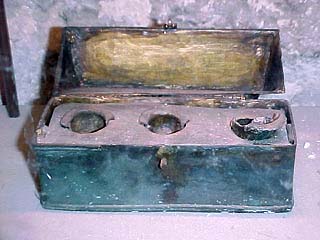|
Saint Martin's Church - description
page 6 |
|
This is the seventh and last page of the booklet about Saint Martin's Church. To go back to the last page click here. To go back to the Saint Martin's main page click here. |
|
This is quite new, being partly built in 1844 and enlarged in 1928. It contains the Organ, a gift to the Church in 1907, built by Messrs. Walker of London, a two-manual with 11 stops and 320 speaking pipes, ranging in size from three inches to nine feet. Hanging in the Vestry are one or two old prints, a list of the Rectors from 1314, and photographs of the Rectors for the last 100 years. One of the windows is made up with 15th century glass, but it is patchwork and not a complete design. One of the most interesting relies of pre-Reformation preserved in the Church is a Christmatory, dating from the 14th century. It is a brass box with three pewter pots for the three holy oils for anointing, at Baptism, Confirmation and Holy Unction. The necessity of keeping the three oils in distinct compartments is insisted upon by Archbishop Alfric (A.D. 995), "Ye ought to have three flasks ready for the three oils, for we dare not put them together in one oil vessel, because each of them is hallowed apart for a particular service". This is one of two remaining Christmatories of pre-Reformation date left in England. It was found hidden in the Nave roof at the restorations about the middle of the last century. It may be seen on application to the Verger. [In fact this is now lodged in the Cathedral museum in the crypt].
^ Whatever may finally be determined to be the date of the Church's foundations, it can never lose its unique association with St. Augustine, King Ethelbert and Queen Bertha, nor its claim to be the oldest existing Church in England. Within these sacred walls, standing since the very beginning of our English history, and which have echoed to the voice of St. Augustine, divine worship has been carried on for over 1,350 years. On leaving the Church, one should turn to the right, walk along the path beside the Church, past the Vestry, and ascend the flight of steps to the new piece of Churchyard. Then turn and admire the wonderful
view described by Dean Stanley as one of the most inspiriting [sic]
in the world. In the foreground St. Augustine's and beyond the mighty
pile of Canterbury Cathedral. From these small beginnings has flowed
the tiny spring of Christianity which has since penetrated the remotest
parts of the earth.
THE STORY OF ST. MARTIN OF TOURS ^ St. Martin was born in Southern Hungary about the year 320 A.D. He came of a good class family, but they were pagans. As a young man Martin heard of Christianity and was favourable towards it. At the age of eighteen he enrolled in the Roman Army, and quickly rose to the rank of Tribune or Legion Commander. On a bitterly cold winter's day he was riding at the head of his troops through the gate of Amiens, when he was accosted by a beggar clad only in rags, and shivering with the cold, who asked Martin for food or money. Having nothing to offer, Martin removed his large red military cloak, drew his sword and cut the cloak in half. Having given half to the beggar, he wrapped the other half about his own shoulders and went on his way. At night, Martin had a vision in which he saw Our Lord with the angels in heaven and wearing the half cloak which he had given to the beggar. Our Lord said to the angels, "See, Martin has given this unto Me". This was the turning point in Martin's life. He soon left the Army and studied under St. Hilarv. He was baptised, entered a monastery, was then ordained and was soon known for his good works. In 370 he was consecrated Bishop of Tours. He passed to the higher life in November, 401, at Candes, at the age of eighty. His last prayer was: "Lord, if I am still necessary to the people, I would not draw back from the work". With much ceremony he was laid to rest at Tours. St. Martin's Day is kept on November 11th. ^ The Lychgate This was designed and erected in 1844. The gates were renewed in.1920.
The Churchyard It is still in use for burials, and is one of three remaining in the City [Is this still true?]. A number of prominent citizens are interred here, among which are several Deans and Bishops. The oldest tombstone is 1686. Air Raids The Church was closed from June 1st to July 11th 1942, through damage by air raids on June 1st, 3rd and 7th. About 75% of the tiles were blown off and the windows were extensively damaged by blast. The Lychgate was badly shaken by a 1,000-1b. high explosive bomb which fell in the road outside. Another of the same size fell in the adjoining field, but failed to explode. It was removed some days later. The Church narrowly escaped destruction by fire on the night of October 31st, 1942, when Canterbury was raided three times. Four incendiary bombs fell and burnt themselves out in the Churchyard. Two of these were within 6 feet of the Church. Two others, intact, were found the next morning. Notice to Organisers of Parties A guide is on duty at the Church on most days, but organisers of parties, large or small, are requested to write beforehand to the Verger, Mr. E. Wilkinson, 18 Littlebourne Road, Canterbury. [Obviously not any more!!] [End of the booklet] ^
|
